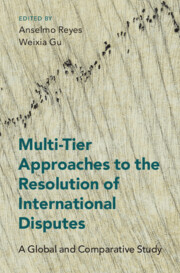Book contents
- Multi-tier Approaches to the Resolution of International Disputes
- Multi-tier Approaches to the Resolution of International Disputes
- Copyright page
- Contents
- Figures
- Tables
- Contributors
- Acknowledgements
- Table of Cases
- Table of STATUTES AND INSTRUMENTS
- Table of Rules, Codes and Guidelines
- Abbreviations
- Part I A Global Overview of Multi-tier Dispute Resolution: Main Themes
- Part II Multi-tier Dispute Resolution in Asia
- Part III Multi-tier Dispute Resolution in the Wider World
- Part IV Conclusion
- 18 Making Multi-tier Dispute Resolution Work
- Bibliography
- Index
18 - Making Multi-tier Dispute Resolution Work
from Part IV - Conclusion
Published online by Cambridge University Press: 09 December 2021
- Multi-tier Approaches to the Resolution of International Disputes
- Multi-tier Approaches to the Resolution of International Disputes
- Copyright page
- Contents
- Figures
- Tables
- Contributors
- Acknowledgements
- Table of Cases
- Table of STATUTES AND INSTRUMENTS
- Table of Rules, Codes and Guidelines
- Abbreviations
- Part I A Global Overview of Multi-tier Dispute Resolution: Main Themes
- Part II Multi-tier Dispute Resolution in Asia
- Part III Multi-tier Dispute Resolution in the Wider World
- Part IV Conclusion
- 18 Making Multi-tier Dispute Resolution Work
- Bibliography
- Index
Summary
Contributors to this book have discerned a welcome trend towards the greater use of multi-tier dispute resolution (MDR). But they have also identified the most problematic form of MDR as that where the same person acts initially as mediator and then, if mediation is unsuccessful, as arbitrator (‘med-arb’). Despite this, med-arb has significant advantages. It is likely to be cheaper than other modes of MDR and its mediation component enables parties to ventilate their genuine concerns and thereby tailor the resolution of their disputes to their real needs. This chapter considers ways of mitigating med-arb’s difficulties so that parties may fully reap its advantages. It discusses how to make med-arb agreements enforceable; how to balance the informality of mediation with the due process requirements of arbitration; and how to ensure that the outputs of med-arb, whether a mediated settlement agreement or an arbitral award, can be enforced.
Keywords
- Type
- Chapter
- Information
- Multi-Tier Approaches to the Resolution of International DisputesA Global and Comparative Study, pp. 417 - 442Publisher: Cambridge University PressPrint publication year: 2021



